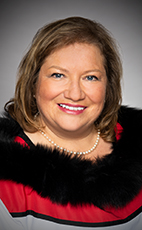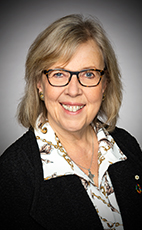44th Parl. 1st Sess.
May 4, 2022 02:00PM
- May/4/22 2:03:22 p.m.
- Watch
Mr. Speaker, yesterday the University of Alberta announced a dedicated place of quiet reflection in memory of friends and family lost in the downing of Ukraine International Airlines flight PS752. As we reflect on the tragedy of this event, we are reminded of the profound effect it has had on the Edmonton Iranian family.
I met personally with families of the victims, who were integral members of our community. We lost beloved university students, professors, doctors and community volunteers. Notably, we lost parents, children, siblings, family and friends.
This tragedy and its effects continue to be felt in Edmonton. As days and years go by, our community continues to mourn and remember those whom we lost. However, this also presents an opportunity to reflect on the importance of those we hold dear and to continue to recognize the amazing community that we call home.
144 words
- Hear!
- Rabble!
- add
- star_border
- share
- May/4/22 7:44:41 p.m.
- Watch
Mr. Chair, I will be splitting my time with the member for Haliburton—Kawartha Lakes—Brock.
I rise tonight to take part in this debate with a heavy heart. Unfortunately, the issue of missing and murdered indigenous women and girls is too prevalent in my northern Saskatchewan riding, and one does not have to look very far to find heartbreaking stories.
Just last September, during the election campaign, the communities of Meadow Lake and the neighbouring Flying Dust First Nation were rattled to the core when a local schoolteacher was shot and killed by her estranged husband. Charlene was 34 years old and the mother of two children.
It is a tragedy when this happens, period, but for indigenous people across the country, it happens at alarming rates, and we all need to be part of changing that. The fact is that indigenous people are overrepresented as victims of violent crime. More specifically, they are over twice as likely as non-indigenous people to experience spousal violence. When looking at the most severe form of intimate partner violence, homicide, a similar pattern emerges. While about 5% of the population is indigenous, one-quarter of intimate partner homicide victims between 2014 and 2019 were indigenous.
I share the story of Charlene because I believe it is imperative that we, as legislators, remember that these are not just statistics but real people with families who are impacted.
I want to focus, in what little time I have, on several positive initiatives that I believe are raising awareness and respectfully remembering missing and murdered indigenous women and girls.
Tomorrow, we will mark Red Dress Day across Canada. It was Métis artist Jaime Black who helped inspire the red dress movement. Her REDress art installation evolved into the annual Red Dress Day and sparked a grassroots movement across North America. Every year, people hang red dresses in private and public spaces to remember and to stand in solidarity with family members and loved ones.
Walking With Our Sisters is another community-based art installation that honours missing and murdered indigenous women and children. Beginning in 2012, people were asked to design and create moccasin tops for their missing and murdered loved ones. Men, women and children from all backgrounds and all parts of Canada sent in 1,600 of these vamps, more than doubling the initial goal of 600. In 2019, this art installation travelled to more than 25 locations across North America.
Another initiative is the faceless doll project. Created in 2012 by the Native Women's Association of Canada, the faceless doll project encourages people to make dolls to represent missing and murdered women and those affected by violence. As I shared earlier, often we can look at the enormity of the problem here in Canada and forget that behind each number and each statistic is a life, and this project reminds us of just that.
Next week, on May 12, Canadians from coast to coast will mark Moose Hide Campaign Day. The Moose Hide Campaign is an indigenous-led grassroots movement that encourages men and boys to stand up against violence toward women and children. With that goal, their challenge to men and boys across Canada is to stand with women and children and speak out against violence toward them; support each other as men and hold each other accountable; teach boys the true meaning of love and respect and how to be healthy role models; heal ourselves as men and support our brothers on their healing journey.
I would like to end by referencing a blog post written by Heather Exner-Pirot and Angela Pratt. Exner-Pirot is a senior consultant with Morris Interactive, and Pratt is the director of economic and community development at the Federation of Sovereign Indigenous Nations in Saskatchewan. The main theme is providing a better future for indigenous women, which I believe is a very important aspect that needs to be addressed in tonight's debate.
They discuss the link between income and safety and quote a study outlining how the rates of domestic violence are impacted by women's income. They write, “Besides exposing Indigenous women to violence, the lack of a decent, stable income and the resulting poverty has many other negative impacts.” Specifically referencing Saskatchewan and accessing good-paying jobs, they continue, “Closing the wage gap for Indigenous women means making sure they can access the best paying jobs in the province. And for Saskatchewan, that means the natural resources sector”. They end the post with a challenge: “Creating a better future for Indigenous women in Saskatchewan, and for the province as a whole, means removing the many barriers that have prevented Indigenous women from financial independence.”
Indigenous women and girls have been the target of violence for far too long. Canada, as a country, cannot fulfill its full potential until this crisis is solved.
823 words
All Topics
- Hear!
- Rabble!
- add
- star_border
- share
- May/4/22 7:54:57 p.m.
- Watch
Mr. Chair, I rise today in the House to speak to a matter that evokes strong emotions on all sides, a matter that speaks to the tragedy of racism and discrimination and a matter that requires continued vigilance to overcome. Of course, I speak of the horrors of the murdered and missing indigenous women and girls in this country.
Before I get into my speech, I would like to thank my colleague, the member for Desnethé—Missinippi—Churchill River, for sharing his time with me this evening.
The stats speak for themselves. Indigenous women and girls in Canada are disproportionately affected by all forms of violence. Although indigenous women make up just 4% of Canada's female population, 16% of all women murdered in Canada between 1980 and 2012 were indigenous. The 2019 general social survey on victimization, along with Stats Canada, has indicated that indigenous women were more likely to experience intimate partner violence than non-indigenous women.
Furthermore, during our study on sex trafficking of indigenous people last June, experts told us that 52% of human trafficking victims are indigenous and that the average age of exploitation of an indigenous girl is, shockingly, just 12 years.
Although the indigenous population up to the age of 14 makes up 7.7% of all Canadian children, they represent 52.2% of the children in care. We also know that studies have highlighted that having a child in the welfare system is the most common feature among women and girls who enter prostitution.
Most alarmingly, the statistics may be even more tragic, as experts told the committee that one of the biggest problems is how difficult it is to accurately track how many victims there are of human trafficking and sex trafficking, as well as to accurately track the correct number of missing and murdered indigenous women and girls. Without real effort from the government to ensure that a robust framework is in place, with adequate resources that are made available for indigenous data collection, in consultation with indigenous experts and organizations, the true story of their reality may never be truly known.
The final report of the National Inquiry into Missing and Murdered Indigenous Women and Girls made 231 calls for justice in 2019. It took two years of waiting for the government's action plan on missing and murdered indigenous women and girls, a plan that many involved called toxic, flawed and unsafe. The government has failed to address one of the core elements in the inquiry: that any plan has an obligation to the victims, their families and all indigenous women and girls, to ensure their voices are reflected so that indigenous women today and future generations of women and girls can live their lives free of violence.
Unfortunately, the government's most recent budget implementation act also fails in this regard. With respect to investments in the budget to address the safety of indigenous women and girls, the Native Women's Association of Canada described its concerns: “We're very concerned that on the surface of this reading of the budget announcement, we don't see where the investment is going to be and we have a very serious concern about that.”
The track record of the government has become abundantly clear. Instead of tackling the systemic inequalities, violence and unsafe conditions for indigenous women and girls in this country, it simply throws money and hopes those issues go away. This will do nothing to empower indigenous women and girls. Rather, it will simply grow bureaucracies here in Ottawa. To be fair, past governments must share the blame in continuing this broken “Ottawa knows best” system, a system that has a profoundly lasting and damaging impact on indigenous culture, heritage and language. For true reconciliation to begin, this paternalistic approach to indigenous people and issues must end.
We must not sideline off-reserve and non-status communities either. Women and girls tend to gravitate to urban centres to escape violence, and that creates greater problems, because they cannot access employment, adequate housing or even shelter, and they become victims of a cycle that has been perpetuated by a lack of resources and inadequate supports for them.
In closing, indigenous women and girls need a safe, culturally supportive environment in which they are free from violence, sexual trafficking and exploitation. If we are honest about reconciliation, the current and succeeding governments have an obligation to honour indigenous perspectives when addressing underlying factors that create the unsafe conditions for women and girls, such as precarious housing, poor living conditions, high rates of unemployment, unstable employment, low working wages and the lack of access to social and economic resources.
I look forward to the questions ahead.
793 words
All Topics
- Hear!
- Rabble!
- add
- star_border
- share
- May/4/22 8:00:02 p.m.
- Watch
Mr. Chair, my colleague touched on a subject that is very important to me. In fact, at yesterday's general meeting of the All-Party Parliamentary Group to End Modern Slavery and Human Trafficking, I was re-elected vice-chair.
We have studied this issue extensively. My colleague mentioned that 54% of human trafficking victims are indigenous women. That is huge. He also said that before concrete solutions to help these women can be proposed, a lot more data and studies are needed.
During the pandemic, some of these numbers were lost. The pandemic really complicated the research being done to get a more accurate picture of human trafficking and its impact on indigenous women. I would ask my colleague to comment on that.
124 words
All Topics
- Hear!
- Rabble!
- add
- star_border
- share
- May/4/22 8:40:24 p.m.
- Watch
Mr. Chair, I thank my colleague, with whom I serve on the Standing Committee on the Status of Women. I must say that it is an honour to work with her.
She was appointed to the committee in the new Parliament. Since I joined the committee in 2019, practically every study the committee has done shows that indigenous women are disproportionately affected. We did a study on the impacts of COVID-19, and we are currently doing one on the impacts of resource development. We have also explored rural issues and the mental load. Every study the committee conducts shows that indigenous women are more likely to be victims.
Why are we still having take-note debates in 2022? When are we actually going to do something?
Taking a first step is indeed important, but what does my colleague think of all these studies that are piling up?
148 words
All Topics
- Hear!
- Rabble!
- add
- star_border
- share
- May/4/22 9:06:26 p.m.
- Watch
Mr. Chair, the real information we need is the stories of victims and the stories of families. Many of them could only enable themselves to tell their stories with the health supports and victim support services that they have around them.
That is why the National Inquiry into Missing and Murdered Indigenous Women and Girls was so important. It was important so we could lay out the investments that were needed, not only to get to the root causes that contribute to the tragedy of missing and murdered indigenous women and girls, but also for the health supports and the victim services that are needed in so many communities, and the infrastructure that is needed. That is the road we are on. I just wish we could, in society, take that road a bit faster than we have been.
139 words
All Topics
- Hear!
- Rabble!
- add
- star_border
- share
- May/4/22 9:57:48 p.m.
- Watch
Madam Chair, my hon. colleague's deep sense of grief and connection was very clear in his speech, with the disproportionately high number of indigenous women and girls who have gone missing from the area of his riding.
I want to specifically ask him if, in reading the report, he took on board the notion that it is time to stop looking at indigenous women and girls solely as victims and look at them as individual human rights holders and defenders of their own rights in a human rights issue that permeates this whole debate.
95 words
All Topics
- Hear!
- Rabble!
- add
- star_border
- share
- menumenu
- notificationsnotifications
- home
- mailmail
- searchsearch








